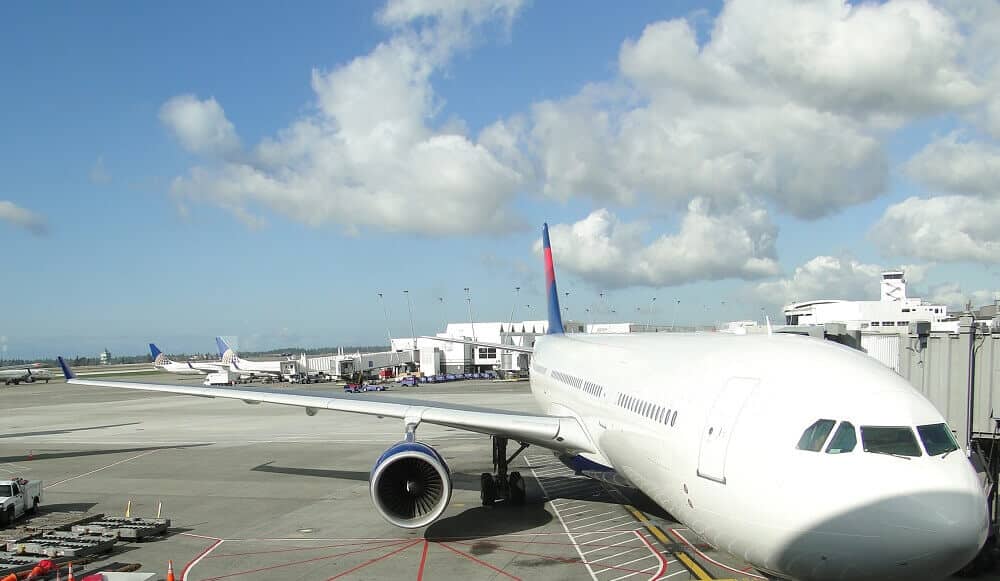SeaTac Paid Sick Leave Ordinance for Hospitality and Transportation Employees

SeaTac’s new Sick Leave Laws have a Turbulent Beginning
The City of SeaTac has seen a roller coaster ride when it pertains to their minimum wage and paid sick leave ordinance. First, the initiative barely passed in a vote, winning in 2013 by only 77 votes. Then the case against the new ordinance went to court, twice, on separate grounds. The most successful case, alleging that the new ordinance should not apply to an airport is not governed by SeaTac, but by the Port of Seattle. The suit first won when a judge declared that the 1,600 workers of the Seattle-Tacoma International Airport were excluded from the jurisdiction of SeaTac. Then, the case was appealed before the Supreme Court, where it was ruled that SeaTac did have the right to inflict minimum wage and sick leave laws on the employees of the Airport.
SeaTac Minimum Wage Schedule
Covered Employees saw their minimum wage increase in 2015 to $15 an hour. In 2017, the new minimum wage is set at $15.34 an hour. The wage is determined annually by the Consumer Price Index for urban wage earners and clerical workers (CPI-W). Rates are announced October 15th of the preceding year and take effect on January 1. Employers are required to provide written notice to their employees through a poster. Tips, gratuities and service charges don’t count toward minimum wage.
SeaTac Paid Sick Leave Ordinance
Employers in SeaTac, and throughout Washington State are finding themselves navigating multiple sick and safe time laws. SeaTac’s sick leave ordinance provides the most comprehensive sick leave benefits to covered employees, ties employer hands, and conflicts with several surrounding city ordinances of its neighbors. Additionally the State of Washington has recently passed a new Sick Leave Ordinance that creates a new layer of sick leave laws that employers must maintain compliance with or face employment law penalties. The purpose of this article is to cover the main points of the SeaTac ordinances and some of the pitfalls for employers who may only have occasional-basis employees in SeaTac and may not be aware of the entire scope of the ordinances. The article will also have links to articles on the sick leave laws of surrounding municipalities Tacoma and Seattle, as well as an overview of Washington State Sick Leave Laws.
SeaTac Paid Sick and Safe Time Law sees unusual Legal opposition
In a surprising turn of legislation, SeaTac voters passed a Paid Sick Leave Ordinance that applies specifically to hospitality and transportation workers. Unlike the surrounding cities of Seattle and Tacoma, SeaTac’s ordinance doesn’t apply to all workers. Under the new ordinance, covered workers will earn 1 hour of sick leave for every 40 hours worked in the City of SeaTac. The ordinance places no minimum number of hours before qualifying for sick leave accrual. Nor does the ordinance place any limits on accrual or usage.
Important Dates for Compliance
The SeaTac Paid Sick Leave Ordinance went into effect on January 1, 2014. There was no added grace period for external employers who have occasional basis employees in SeaTac or for small businesses.
Covered Employees under the Paid Sick Leave Ordinance
Employees that are covered under the SeaTac Sick Leave Law include hospitality workers and transportation workers. Hospitality workers are workers at any City Hotel with at least 30 workers and 100 rooms. It also includes any retail operation with 10 or more non-managerial employees.
- Hotels with 100+ rooms and 30+ non-managerial employees
- Retail operations with 10+ non-managerial employees (such as food establishments)
Transportation workers are any worker who 1) work for an employer with at least 25 or more nonmanagerial employees at any place that 2) the following services are performed. Those services include any employee who checks passengers in, works in baggage claim, wheelchair escort services, baggage or cargo handling. It also includes rental luggage cart services, aircraft cleaning (interior, carpet, exterior, lavatory), aircraft fueling, ground transportation. Lastly, janitorial or custodial service, facility maintenance services, security checks, or customer services are also included.
Transportation workers also include car rentals, shuttles, vans and buses, and parking lots. There are limits on the number of the fleet in order for the businesses workers to be included. The limits are as follows:
- 100 cars or shuttles
- 10 Vans or buses
- 100 parking spaces
Exclusions to Earned Sick and Safe Time
Employees who are exempt from the new ordinance include non-hospitality and transportation workers. Additionally, managerial workers are exempt from the new ordinance. Non-managerial employees who are employed by very small employers are also included. This would include hospitality workers whose employers have fewer than 10 employees. Transportation employees excluded would include employers whose sizes fall below those discussed in the section above.
Lastly, union employees can be exempt from the law if the collective bargaining agreement is specific and set forth in unambiguous terms.
Allowable Uses for Earned Sick and Safe Time Leave
Sick Leave can be used for several reasons for themselves or for a family member. Reasons include mental or physical illness, injury, or health condition. Workers can also use sick leave to obtain a medical diagnosis, treatment of a mental or physical illness, injury or health condition. This includes preventive care.
Safetime can be used when the covered worker or a family member is a victim of domestic violence, stalking or sexual assault. They can use paid leave to seek legal or law enforcement assistance or remedies. This includes preparing for and participating in, any civil or criminal legal proceedings resulting from the domestic violence, sexual assault, or stalking. Safetime can also be used to seek treatment from a health care provider for any physical or mental injuries caused by domestic violence, sexual assault, or stalking.
Lastly, paid sick and safe time can be used when the employee’s place of business, or child’s school or place of care, has been closed by a public official to limit exposure to an infectious agent, biological toxin or hazardous material.
- Mental or physical illness, health condition or injury: Treatment, diagnosis, preventative care
- Domestic Violence, Sexual Assault, Stalking:
- Assistance from Legal or Law Enforcement, Participate in or prepare for civil or criminal proceedings
- Care from Health Care Provider for physical or mental injuries
- Public official closes business, place or care or school for safety reasons to prevent contamination of hazardous materials, infectious agent, or biological toxin.
Family Member Definitions
Allowable Family members under the ordinances include dependents, spouses, parents, grandparents, and grandchildren.
- Children under 18 yrs old
- Spouses or Domestic Partners
- Children over 18 yrs old who are not able to self-care
- Parents or Guardians
- Grandparents and Grandchildren
Accrual of Safe and Sick Time
SeaTac’s Ordinance provides no probationary period for new employees to accrue or use sick leave. Covered employees immediately start accruing sick leave on the first date of employment. Once employees have worked their first 40 hours, they are immediately eligible to use that first accrued hour of sick leave. Further, there is no limit to the number of hours employees can accrue. Nor is there a sick leave usage limit.
Sick Leave Bank and Minimum Usage
SeaTac doesn’t require a sick leave bank because it requires sick leave to be paid out annually.
Any unused, accrued sick leave must be paid out in a lump sum at the end of the year. This means that Paid Sick Leave doesn’t roll to the following year.
Coordinating with Paid Time Off Policies
SeaTac’s ordinance makes no mention of existing time off policies, doesn’t address front loading, and doesn’t provide a method for companies to use existing policies to meet the new Sick Leave laws. Employers who already offer Paid Time Off (PTO) should look at their policies and consult an employment attorney. The SeaTac laws are vague and strick for employers.
Reasonable Documentation and notification of sick leave usage
SeaTac’s ordinance is particularly hairy for employers as it allows for no documentation that sick leave is used for allowed reasons. Even when employees use 3 or more consecutive days of sick leave, employers are not allowed to ask for any type of documentation that sick leave was used legally and not abused.
Promotion of Full-Time Employment
SeaTac also requires that employers who have additional hours first offer those hours to part-time workers before they can hire additional part-time employees or subcontractors. This prevents employers from temporarily hiring employees for short-term hourly increases and the ordinance does not address what happens when the hours must decrease again. The ordinance also prevents employers from maintaining a cheaper, part-time staff by forcing employers to offer full-time employment to existing employees and thus increases the total expenses through other benefits and required health care options.
Tips and Service Charges
All tips and service charges must be paid to the non-supervisory staff who perform the services. This includes room service tips, amounts collected from banquets, catered meetings, and porterage service. Management and owners of the hospitality or transportation service cannot share in those tips and charges collected.
Displaced Workers, Successor Employer List
Employees who are not retained when their employer is changed to a successor employer must be put on a Successor Employer List and listed by seniority. Successor Employers must retain employees based on seniority and when hiring new employees, must first hire employees on the successor employer list first. They may not hire new employees of the street or through recruiting until they have exhausted the successor employer list first. This takes away employer’s ability to hire or manage a workforce based on merits, qualification, or effectiveness.
Fines and Remedies provided by the SeaTac Sick Leave Ordinance
Businesses are prohibited against retaliating against employees who use their sick or safe time leave. As SeaTac doesn’t have a cap on accrual or usage and doesn’t allow for any kind of employer documentation of sick leave usage, employees have a long leash for abuse. The ordinance allows for employees to seek redress through the City and through a civil suit. Employees can seek repayment of attorney fees, double their missed wages, and other fines and penalties.
Notification and Records
Businesses must maintain records for a minimum of 2 years. Washington State’s new Sick Leave law requires a 3 year retention period, as does Tacoma and Seattle. It would be wise for businesses in SeaTac to maintain all records for the 3-year minimum required by the state. Records must include hours worked in SeaTac, wages, and benefits provided to the employee. It must also include the accrual hours, usage hours and documentation that they unused hours were paid out at the end of the year.
Pitfalls for Employers to Avoid
- The SeaTac ordinance prohibits limits on accrual or usage of sick leave. This means that employers must track time for all employees and cannot limit sick days. It also means that employers who are planning to satisfy the Washington State sick leave laws through front loading cannot plan to do the same to satisfy SeaTac sick leave requirements. Additionally, as SeaTac doesn’t limit usage or accrual and Washington State has not yet defined any accrual or usage limits.
- The payout of sick leave at the end of the year motivates employees to work during sickness and increases the likelihood that illness will travel across the company and infect more coworkers. Other neighboring cities and states don’t require sick leave to be paid in a lump sum at the end of the year. This means that unused accrued sick leave is usually rolled over to be used the next year. SeaTac, however, requires a lump sum payment and that encourages employees to continue working so their sick leave can be a “year-end bonus” to be paid out.
- Employers cannot request documentation when sick leave is used for 3 or more consecutive days. This is different from Washington, Seattle, and Tacoma, which do allow for documented absences after 3 days of sick leave. Employers may have to track both accrued sick leave separately and not combine the sick leave days to meet the SeaTac ordinance.
- Employees who only work in SeaTac city limits on an occasional basis only accrue SeaTac sick leave when they work in city limits and can only use sick leave when they are working in SeaTac. This conflicts with Seattle, Tacoma, and Spokane, laws which allow accrued local sick leave or be used by the employee regardless of if the employee is scheduled to work in city limits or not. This also creates a records nightmare for the employer as employees cannot use SeaTac sick leave unless they are scheduled to work in SeaTac. For transportation employees, who may work in and out of SeaTac throughout a regular shift, interpretation of the law gets hairy.
- Employers must maintain records of when the employees worked in SeaTac, the accrued sick leave, leave used, wages earned and benefits provided. SeaTac minimum wage may mean that employees earn different hourly wages during a regular 8-hour shift. It also means that employees may accrue or have access to differently paid leave during the same shift. Employers can rely on employees to report when they cross city limits. However, that can have its own pitfalls as employees can be motivated to linger in SeaTac for the added benefits. Employers should consider a GPS Timekeeping solution such as SwipeClock offers that will automatically log when an employee crosses the boundaries and will automatically track and pay the sick leave hours and required minimum wages for that time.
- Employers must promote part-time employees to full-time status before hiring new employees. This eliminates merit-based hiring.
- The Ordinance encourages employees to sue to recover damages, injunctive relief, and attorney costs and fees. This is more expensive for employers to manage from a cost standpoint. The City has no obligation to incur any expense to investigate or enforce the ordinance, which may leave legal suits as employees only option, and the most costly remedy available.
Let SwipeClock Help
Businesses who have employees in SeaTac, not to mention a growing list of other cities in Washington or surrounding states, may have to comply with multiple conflicting City ordinances defining Sick leave accrual and usage laws. Additionally, these businesses have to also comply with Federal Overtime Laws, the Family Leave Medical Act and any other national or local laws that are enacted. SwipeClock provides a comprehensive array of workforce management and time tracking tools that can help businesses to more easily stay in compliance with local and national laws. Records are effortlessly kept for years and accrual is automatically tracked and reported to employees according to the state and city laws. Additionally, with GEO-timekeeping clocks, businesses can effortlessly track time worked in specific cities to ensure compliance.
Resources
http://www.ci.seatac.wa.us/Modules/ShowDocument.aspx?documentid=8233
http://www.ci.seatac.wa.us/index.aspx?page=681
Seattle Paid Sick and Safe Time Ordinance
Spokane Earned Sick and Safe Time Ordinance
Washington State Sick Leave Law
Washington’s Sick Leave Laws Comparison Chart
Written by Annemaria Duran. Last Updated on February 7, 2017
Simplify HR management today.
Simplify HR management today.
Your Guide to GPS Time Tracking (Geofencing)
Updated March 19, 2024 When your business has employees working remotely or at various job sites, time tracking can become a challenge, particularly if the company relies on physical clocks for punching in and out. But offering a mobile app or web-based tracking solution can cause some concerns. You might wonder whether employees are clocking…
Read MoreThe Employer’s Guide to Federal & State Meal/Rest Break Laws [See all 50 State Laws Here]
Updated January 23, 2024 Under the federal Fair Labor Standards Act (FLSA), employers are not required to provide meal or rest break periods to employees. However, some states do have laws in effect dictating when and how often an employee should receive a break, as well as whether these breaks are paid or unpaid. In…
Read More




